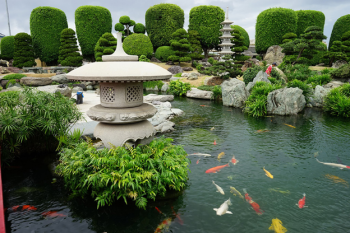To have a beautiful and healthy Koi aquarium is not simple for beginners because there are many factors that affect the health of fish. Therefore, to ensure a good ecosystem for Koi fish to grow healthy and beautiful, we need to know some basic knowledge as follows:
- Water Environment
- Koi are voracious and grow quickly, their size when they are adults is quite large, so they need a large enough environment and not polluted for fish to grow healthy.
- The water environment must not only be clean, but indicators such as pH, NH3, etc. it is very necessary to be monitored regularly (Koi fish tolerate pH from 4 to 9 but the best threshold for Koi is from 7 to 8, the difference in the day is not more than 0.5).
- When changing the water, you should not change more than 30% of the water in the tank to avoid the fish from being shocked, depending on the water environment, you can change the surface water and drain the bottom periodically (you can change 5% of the surface water immediately or 5 or 7 days you flush the bottom once and it also depends on the density of farmed fish..). The water supplied to the lake must also be treated or ensured that there are no toxins such as chlorine or bacterial infections....
- The most suitable water environment temperature is from 20 to 27 degrees Celsius.
- The oxygen content in the lake needs to be at least 2.5mg/l, so in the lake there needs to be a bubble machine or waterfall, and a nozzle to generate enough oxygen.
- Avoid letting algae grow too much because they will suck up all the oxygen in the water and suffocate the fish, to kill algae, you can use UV lamps or plant some beneficial aquatic plants in the filtration system or lakeside.
- Ensure the requirements on your fish will have a beautiful color and develop well.
- About feed
- Koi fish are omnivorous, when they are 3 days old, the fish eat all the yolks and then they eat outside food such as bo bo and other animals, in addition, the farmer can also feed the yolk of cooked eggs.
- When the fish are 15 days old, they switch to eating bottom animals, if we raise them for breeding, we have to feed them such as worms. or raising adventurous animals...
- Fish about 1 month old or older are fed omnivorous and synthetic foods such as bran pellets.
- It is recommended to use food that is bran in the form of pellets or fresh, the ration is not more than 5% of the fish's body weight, each time feeding the fish for about 5 minutes, if you see leftovers, remove them to avoid water pollution.
- Feed 3 to 5 times a day, each time 3 to 4 times apart so that the fish have time to digest the food.
- Note that in the cold season below 17 degrees Celsius, fish are less active and cold-blooded, so it is difficult to digest food, you should feed very little or wait a few days to feed a small amount.
- Some common diseases in Koi fish during farming
- White spot disease: It is white fungus, one of the most common manifestations in Koi fish, when the fungus grows a lot, it will eat cells and subcutaneous fluids, causing weak fish to die.
- Anchor worms: When suffering from this disease, fish often eat poorly, itch unpleasantly, are emaciated and swim slowly. The wounds caused by anchor worms create conditions for bacteria to attack and fungi to grow, making fish diseases more and more severe.
- Skin flukes, gill flukes: Fish often jump out of the water, itching...
- Ulcers: Bruises appear on the body, tail or fins of the fish, etc., gradually becoming ulcers.
- Tail rot: The tail fin is swollen, inflamed, peeling... leading to necrosis
- Red spot disease: Red hemorrhagic dots appear on the body of the fish, the fish stops eating, is weak and swims lethargy on the water, if not treated in time, leading to torn fins, decay and amputation, areas on the body hemorrhage causing purulent ulcers...
- Fish lice disease: Fish lice parasitize on the skin, fins, gills, mouth, they suck blood and at the same time secrete poisonous fluids that make fish swollen red, creating conditions for bacteria, fungi, etc. invading and causing disease. Fish lice are active and suck fish blood at night, so fish often itch uncomfortably, jump out of the water...
- Shaggy disease: Signs of protruding fish eyes, swollen and ruffled bodies, fish eat little, weak, swim near the water surface, you should separate the fish into the convalescent tank and treat it promptly.
Above are some knowledge and experience in the process of playing and caring for Koi fish to share with you!





